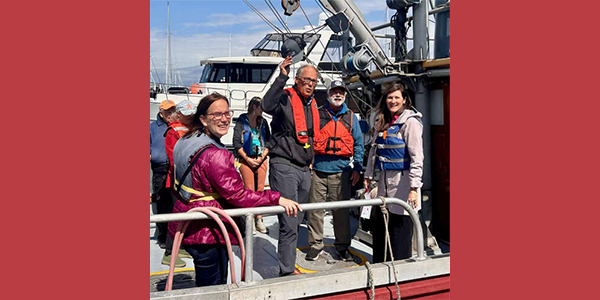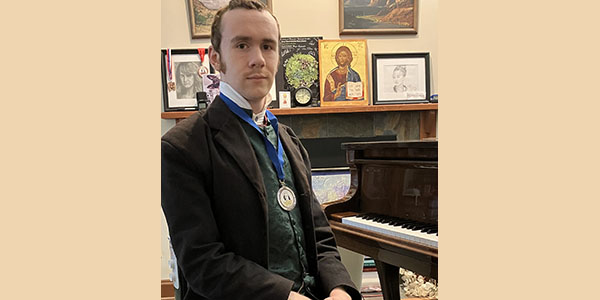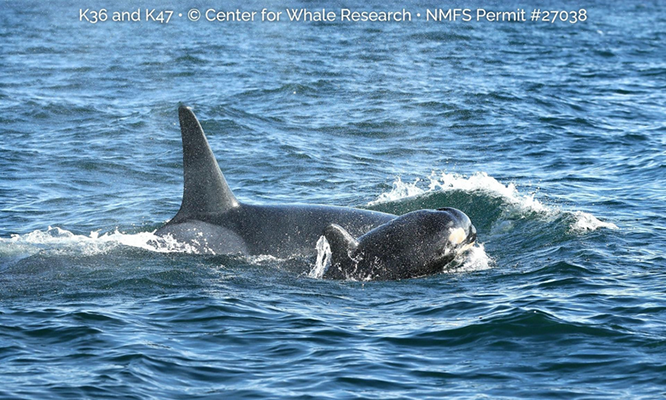Tour of kelp beds, eelgrass meadows illustrates research, underscores climate issues around health of the Salish Sea
||| FROM NANCY DEVAUX for SALISH CURRENT |||
Gov. Jay Inslee visited San Juan Island last weekend, where he joined the Friends of the San Juans for a boat tour on Saturday afternoon. During the tour, researchers pointed out kelp beds and eelgrass meadows and discussed monitoring and restoration initiatives that are projects in part funded by the Climate Commitment Act (CCA).
Inslee accompanied Friends of the San Juans staff and University of Washington Marine Labs researchers on the Kittiwake research vessel to talk about the health of the Salish Sea and current scientific studies, and to raise awareness about CCA-funded investments to help safeguard marine ecosystems and coastal communities.
Research in the works
The group visited kelp beds off of Brown and Turn islands on the boat tour, said Tina Whitman, science director of Friends of the San Juans. Bull kelp forests provide critical habitat for a wide range of species and other ecosystem functions, including primary production and cycling of nitrogen and carbon.
Declining kelp beds are being studied by the Samish Tribe, building on research by Friends of the San Juans.
Inslee lives on Bainbridge Island, where kelp has all but disappeared, so viewing the beds was of particular interest to him.
“We also focused on eelgrass on the boat trip, as well as kelp,” Whitman reported. Friends of the San Juans is involved in collaborative eelgrass mapping and a 20-year health assessment project focused on identifying resilient meadows for protection. Data collected this summer will build upon detailed surveys completed last summer in 21 local bays. Both sets of data will be compared to a 2003 survey, providing comprehensive insights into eelgrass changes over the past 20 years.
Last summer’s mapping revealed significant eelgrass declines in 12 bays. These losses are significant because the shorelines in the islands are a critical intersection for various marine species, including forage fish, juvenile chinook salmon and the critically endangered Southern Resident killer whales.
Whitman said the CCA is also important for leveraging funds, such as a recent $73.6 million grant from the National Oceanic and Atmospheric Administration. In San Juan County, the Samish Indian Nation will use $499,000 in partnership with Friends of the San Juans to boost community and shoreline resiliency to sea level rise while conserving ecological and cultural priorities and values.
The Washington Department of Ecology announcement of the grant illustrates how funds can be leveraged: “CCA funding also supported Ecology’s efforts to apply for the Climate Resilience Regional Challenge grant in partnership with nine other state agencies, five local governments, four Tribal governments and organizations, two academic institutions, and six nongovernmental entities.”
After the boat trip, Inslee told the Salish Current, “I was glad to see the work happening to study and protect eelgrass and bull kelp habitats, which are so critical for our marine ecosystem here in the Salish Sea. The Climate Commitment Act is funding key research and surveys of kelp forest health being done by the Samish Indian Nation and partners. I want to thank the Friends of the San Juans and UW Friday Harbor Labs for hosting us.”
Capping pollution, investing in communities
The Legislature passed the CCA in 2021, creating a market-based “cap-and-invest” program designed to reduce greenhouse gas pollution.
CCA establishes a limit, or cap, on greenhouse gas emissions, requiring that the state’s largest emitters buy allowances to pay for their carbon emissions. The cap is designed to reduce greenhouse gas emissions by 95% by 2050, based on levels from 1990. Industries pay for each metric ton of carbon emitted; prices have ranged between $48.50 and $63.03 per ton. The cap gradually decreases over time, making fewer allowances available. As a result, polluters face higher costs and are therefore incentivized to adopt cleaner methods of operation.
With the funds collected by auctioning pollution allowances, $2.2 billion was generated during the act’s first year alone, used to assist communities all over Washington. The State uses revenue collected for job creation, investments in clean buildings and transportation, and enhancements in community resilience against climate change — helping to transition away from using fossil fuels.
The CCA specifies that 35% of funds raised are designated for projects that benefit overburdened communities, with a minimum of 10% going to projects with tribal support. Overburdened communities are historically subject to health, social and environmental inequities, and are the communities most impacted by air pollution.
In San Juan County
According to the governor’s office, CCA investments in San Juan County have reached approximately $3.7 million. These funds include grants provided to San Juan County and the Town of Friday Harbor for climate planning, to the Conservation District for wildfire resilience initiatives, to the Port of Friday Harbor for electric-vehicle charging stations, and to community facilities including the Orcas Center in Eastsound, the food bank in Friday Harbor and the Mullis Community Senior Center for the installation of solar arrays and batteries.
Also included is nearly $1 million allocated for salmon recovery projects including kelp conservation, tideland and riparian restoration, and to the Department of Natural Resources for 184 acres on Blakely Island that was reclassified from trust land status, which is typically subject to logging, to conservation status.
Not directly allocated to San Juan County, one of the largest CCA investments that will directly impact island life is the production of five new hybrid-electric ferries. Bids went out nationwide in May, representing a major step forward for electrification of the fleet.
**If you are reading theOrcasonian for free, thank your fellow islanders. If you would like to support theOrcasonian CLICK HERE to set your modestly-priced, voluntary subscription. Otherwise, no worries; we’re happy to share with you.**









Thank you Friends of the San Juans for this important work on behalf of nature. The fact that the governor always includes Friends and looks to Friends’ expert staff of scientists and directors when it comes to environmental issues in the Salish Sea and San Juan Islands bioregion, speaks volumes. We are grateful.
As a 50 yr user of Eastsound Water, I am amazed that anyone would listen to Smith. Check out his past. Jim Nelson and Teri Nigretto are two of the most honest people I have k own in my 90 yrs. They have always wanted what was best for Orcas.
*I understand this is not on the correct article, but here it is anyway*
John, this is not a case of “who you know”, but “what you know”.
One can think one’s actions are morally justified, even when they’re not.
Do the ends justify the means?
Look at the evidence.
If you come to the same conclusion you hold now, that’s great. At least it’s informed.
My recommendation (as an uppity-youth) is don’t base your opinion merely on the endorsement of the good-ol’-boys network, but on the evidence given to you.
For a start: https://docs.google.com/document/d/1nVopgpwe7b1LYG-cR8VMd5CjltQCaDE1OfgOY1y9SZ4/pub
John, you’re commenting on the wrong article. This one is about the Friends of the San Juans, not EWUA.